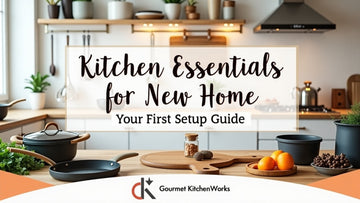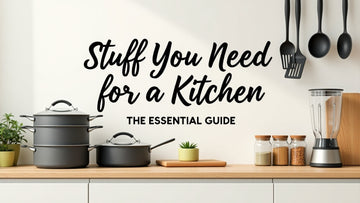10 Proven Ways to Organize Your Kitchen Like a Pro Chef for Maximum Efficiency
by Michele Ekins on May 26, 2025

Ever wondered how professional chefs keep their kitchens in pristine condition even in the middle of chaos? Learning how to organize your kitchen like a culinary pro can revolutionize your cooking experience. A well-arranged kitchen doesn’t just look good—it saves time, enhances efficiency, and makes cooking a joy rather than a chore.
Professional kitchen organization is all about strategic placement, minimal clutter, and workflow optimization. From bustling restaurant kitchens to efficient home setups, the goal is always the same: get the job done quickly and safely. Whether you’re preparing a five-course meal or your morning omelet, your space should work for you—not against you.
But most home cooks face challenges: cluttered countertops, overflowing drawers, and disorganized pantries. These obstacles not only slow you down but can completely derail your cooking mojo. Fortunately, with the right strategies and a little inspiration, you can reclaim your kitchen space and bring pro-level order to your culinary chaos.
Embrace the 'Mise en Place' Philosophy
One of the foundational concepts behind a professional kitchen’s flawless operation is the French culinary principle known as mise en place, which translates to "everything in its place." This method emphasizes preparation and organization before the cooking even begins.
In a home kitchen setup, adopting the mise en place method can dramatically improve your efficient kitchen workflow. Before you cook, set out all your ingredients, pre-measure them, and prep everything from chopping veggies to marinating meats. Not only does this reduce stress, but it allows for smooth, uninterrupted cooking.
Here’s how to apply mise en place to your home:
-
Pre-measure and prep ingredients: Use small bowls or containers to portion everything before you start.
-
Keep essential tools within reach: Place your knives, spatulas, and ladles in a nearby drawer or wall-mounted rack.
-
Clean as you go: The principle of “clean as you go” ensures you don’t end up with a mountain of dishes post-dinner.
By incorporating how to organize your kitchen strategies from professional chefs, you’ll enjoy cleaner counters, faster meals, and fewer culinary mistakes.
Declutter and Prioritize Essential Tools
You can’t organize clutter. And if you want to organize your kitchen like a chef, that means eliminating what you don’t use and emphasizing what you do. The first step in kitchen decluttering tips is ruthless honesty—if it hasn’t been used in six months and it’s not a seasonal item; it probably needs to go.
Professional kitchens are stocked with essential kitchen tools—nothing more, nothing less. At home, your focus should be on high-quality, multi-functional tools that stand the test of time.
Here’s a minimalist yet effective checklist of kitchen must-haves:
-
Chef’s knife: Your kitchen workhorse. Invest in one with great balance and sharpness.
-
Cutting boards: Preferably wood or plastic; keep a few handy to separate veggies and meats.
-
Stainless steel pans: Versatile, durable, and essential for searing, sautéing, and more.
-
Mixing bowls: A nesting set of various sizes will cover all your baking and prep needs.
Once you’ve narrowed down your arsenal, focus on utensil storage. Use magnetic strips, drawer organizers, or wall-mounted containers to keep everything accessible. Remember, clutter-free spaces not only look better—they function better too.
Need help deciding what to keep? Ask yourself, “Does this tool make my cooking easier, faster, or better?” If not, it’s time to part ways.
Optimize Storage Solutions
Efficient storage is key when learning how to organize your kitchen effectively. Whether you’re working with a spacious layout or a cozy corner kitchen, smart kitchen storage ideas make all the difference.
Maximize small kitchen organization by utilizing overlooked areas. Walls, cabinet backs, and even under-sink spaces can become valuable real estate.
Consider implementing the following space-saving kitchen tips:
-
Vertical space: Use hanging racks, floating shelves, or pegboards to store pans, utensils, or spices.
-
Clear, labeled containers: Keep your pantry uniform and easy to navigate with labeled jars for grains, snacks, and spices. Pantry labeling enhances visibility and reduces food waste.
-
Drawer dividers: No more rummaging through tangled spatulas. Keep your tools sorted by function using adjustable dividers.
-
Pull-out shelves and under-cabinet racks: Make deep cabinets more functional and accessible.
A streamlined kitchen doesn’t just look organized—it works more efficiently. You’ll find ingredients faster, waste less food, and clean up in half the time.
With these hacks, how to organize your kitchen won’t feel like a daunting task. Instead, you’ll feel empowered, knowing everything has a purpose and a place.
Design an Efficient Kitchen Layout
The golden rule of functional kitchen design is the kitchen work triangle, which connects the sink, stove, and fridge—the three busiest spots in any cooking space. A well-planned triangle reduces unnecessary steps and makes every movement intentional.
To improve your functional kitchen design, break down your space into zones:
-
Prep Zone: Include cutting boards, knives, and mixing bowls.
-
Cooking Station: Store pots, pans, spices, and utensils near the stove.
-
Cleaning Area: Organize dish soap, scrubbers, and drying racks near the sink.
For compact kitchens, utilize wall space for storage and avoid cluttering the triangle. In larger kitchens, consider adding islands or carts to enhance efficiency.
By understanding how to organize your kitchen based on workflow, not just aesthetics, you create a system that mirrors professional kitchen organization. And that’s when the magic starts to happen.
Maintain Organization with Regular Practices
Even the most perfectly arranged kitchen can descend into chaos without upkeep. The secret to staying organized? Consistent habits. To master how to keep your kitchen clean and tidy, it’s crucial to develop a routine.
Here’s what you can do:
-
Weekly cleanouts: Check for expired food, reorganize pantry shelves, and wipe down drawers.
-
Monthly reviews: Assess your tool inventory and see if anything can be stored, replaced, or tossed.
-
Family participation: Encourage all household members to return items to their proper places.
Think of kitchen upkeep as a time-saving cooking habit. The less time you spend searching for tools or ingredients, the more time you can spend creating delicious meals. Remember, it’s not just about organizing kitchen for better cooking—it’s about maintaining a joyful, functional space where creativity thrives. For more such information, check out: Gourmet Kitchenworks!
FAQs (Frequently Asked Questions)
Q: How do professional chefs organize their kitchens?
A: They follow the mise en place method, keep items they use most frequently within reach, and maintain a strict cleanliness standard. Kitchen zones are clearly marked for prep, cooking, and cleaning.
Q: What's the best way to organize kitchen drawers?
A: Use drawer dividers to separate items by category. Keep the most-used tools in the top drawers and relocate rarely used gadgets to bottom storage.
Q: How can I maximize storage in a small kitchen?
A: Utilize vertical storage like wall-mounted hooks, magnetic strips for knives, and labeled pantry containers. Stackable bins and multi-functional furniture also help in small kitchen organization.
Q: What kitchen tools should I absolutely keep?
A: Keep essentials like a chef’s knife, measuring cups, cutting board, whisk, and stainless-steel pans. Avoid one-trick gadgets unless they are used frequently.
Q: How often should I reorganize my kitchen?
A: Plan for a monthly reset to reflect seasonal changes, shopping habits, and new tools. Regular decluttering keeps your space dynamic and efficient.




